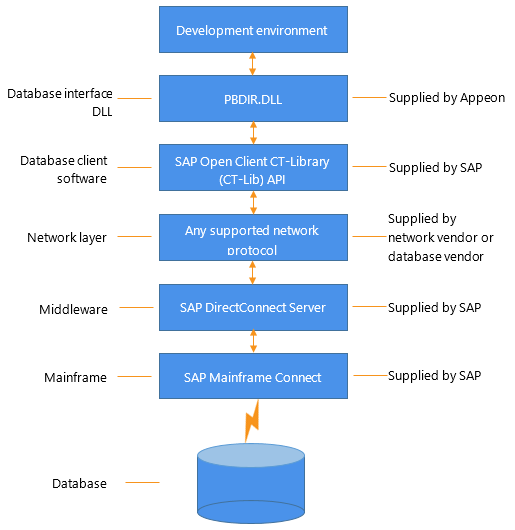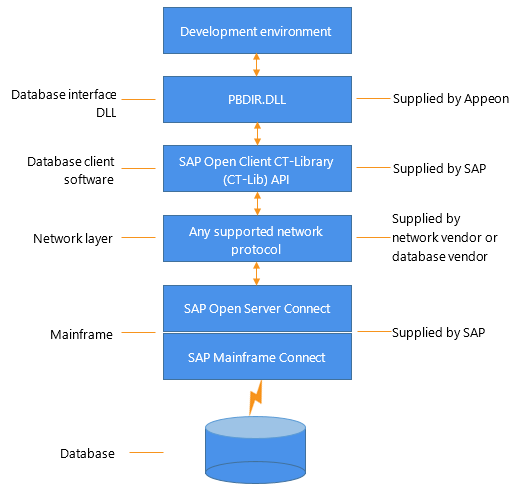This section describes how to use the DirectConnect interface in InfoMaker.
The DirectConnect interface uses SAP Sybase's Open Client CT-Library (CT-Lib) API to access a database through SAP Sybase middleware data access products such as the DirectConnect for OS/390 component of MainFrame Connect and Open ServerConnect.
Accessing Unicode data
InfoMaker can connect, save, and retrieve data in both ANSI/DBCS and Unicode databases. When character data or command text is sent to the database, InfoMaker sends a DBCS string if the UTF8 database parameter is set to 0 (the default). If UTF8 is set to 1, InfoMaker sends a UTF-8 string.
The database server must have the UTF-8 character set installed. See the description of the UTF-8 database parameter in the online Help for more information.
A Unicode database is a database whose character set is set to a Unicode format, such as UTF-8, UTF-16, UCS-2, or UCS-4. All data must be in Unicode format, and any data saved to the database must be converted to Unicode data implicitly or explicitly.
A database that uses ANSI (or DBCS) as its character set might use special datatypes to store Unicode data. These datatypes are NCHAR, NVARCHAR, and NVARCHAR2. Columns with this datatype can store only Unicode data. Any data saved into such a column must be converted to Unicode explicitly. This conversion must be handled by the database server or client.
SAP Sybase DirectConnect is a data access server that provides a standardized middleware interface between your applications and your enterprise data sources. Data access services to a particular database are defined in a DirectConnect server. Since a DirectConnect server can support multiple access services, you can access multiple databases through a single server.
When you use the DirectConnect interface to connect to a particular database, your connection is routed through the access service for that database. An access service consists of a named set of configuration properties and a specific access service library.
To access DB2 data on an IBM mainframe through a DirectConnect server, you can use the DirectConnect interface to connect through either a DirectConnect for MVS access service or a DirectConnect Transaction Router Service (TRS).
TRS provides fast access to a DB2/MVS database by using remote stored procedures. The DirectConnect interface supports both versions of the TRS library: TRSLU62 and TRSTCP.
The DirectConnect server operates in two modes: SQL transformation and passthrough. The DirectConnect interface for DB2/MVS uses passthrough mode, which allows your InfoMaker application to have direct access to the capabilities of the DB2/MVS data source.
SAP Sybase's Open ServerConnect supports mainframe applications that retrieve and update data stored on the mainframe that SAP Sybase client applications can execute. Client applications can connect directly to a DB2/MVS database through an Open ServerConnect application residing on the mainframe, eliminating the need for an intermediate gateway like DirectConnect. (This type of connection is also known as a gateway-less connection.) In addition, an Open ServerConnect application presents mainframe Remote Procedure Calls (RPCs) as database stored procedures to the client application.
To access DB2 data on an IBM mainframe through Open ServerConnect, you can use the DirectConnect interface to connect through Open ServerConnect for IMS and MVS.
To select how InfoMaker accesses the database, use the Choose Gateway drop-down list on the Connection tab of the DirectConnect Database Profile Setup dialog box and select one of the following:
-
Access Service
-
Gatewayless
-
TRS
All the DBParm parameters defined for the DirectConnect interface are applicable to all three connections except the following:
-
HostReqOwner applies to Access Service and Gatewayless only
-
Request, ShowWarnings, and SystemOwner apply to Access Service only
-
UseProcSyntax applies to Gatewayless only
See the online help for the complete list of DBParm parameters applicable to the DirectConnect interface.
The following figure shows the basic software components required to access a database using the DirectConnect interface and the DirectConnect middleware data access product.
Figure: Components of a DirectConnect connection using DirectConnect middleware

The following figure shows the basic software components required to access a database using the DirectConnect interface and the Open ServerConnect middleware data access product.
Figure: Components of a DirectConnect connection using Open ServerConnect middleware

The DirectConnect interface uses a DLL named PBDIR.dll to access a database through either DirectConnect or Open ServerConnect.
Required DirectConnect versions
To access a DB2/MVS database through the access service, it is strongly recommended that you use DirectConnect for MVS access service version 11.1.1p4 or later.
To access a DB2/MVS database through TRS, it is strongly recommended that you use DirectConnect TRS version 11.1.1p4 or later.
For information on DirectConnect for MVS and TRS, see your DirectConnect documentation.
Required Open ServerConnect versions
To access a DB2/MVS database through Open ServerConnect, it is strongly recommended that you use Open ServerConnect IMS and MVS version 4.0 or later.
For information on Open ServerConnect for MVS, see your Open ServerConnect documentation.
The DirectConnect interface supports the InfoMaker datatypes listed in the following table in reports.
|
Char (fewer than 255 characters) |
Long VarChar |
|
Char for Bit Data |
Real |
|
Date |
SmallInt |
|
Decimal |
Time |
|
Double Precision |
Timestamp (DateTime) |
|
Float |
VarChar |
|
Integer |
VarChar for Bit Data |
Before you define the interface and connect to a database through the DirectConnect interface, follow these steps to prepare the database for use:
-
Install and configure the SAP Sybase middleware data access products, network, and client software.
-
Install the DirectConnect interface.
-
Verify that you can connect to your middleware product and your database outside InfoMaker.
-
Create the extended attribute system tables outside InfoMaker.
Step 1: Install and configure the SAP Sybase middleware product
You must install and configure the SAP Sybase middleware data access product, network, and client software.
To install and configure the SAP Sybase middleware data access product, network, and client software:
-
Make sure the appropriate database software is installed and running on its server.
You must obtain the database server software from your database vendor.
For installation instructions, see your database vendor's documentation.
-
Make sure the appropriate DirectConnect access service software is installed and running on the DirectConnect server specified in your database profile.
or
Make sure the appropriate Open ServerConnect software is installed and running on the mainframe specified in your database profile.
-
Make sure the required network software (such as TCP/IP) is installed and running on your computer and is properly configured so you that can connect to the DirectConnect server or mainframe at your site.
You must install the network communication driver that supports the network protocol and operating system platform you are using.
For installation and configuration instructions, see your network or database administrator.
-
Install the required Open Client CT-Library (CT-Lib) software on each client computer on which InfoMaker is installed.
You must obtain the Open Client software from SAP. Make sure the version of Open Client you install supports both of the following:
The operating system running on the client computer
The version of InfoMaker that you are running
Required Open Client versions
To use the DirectConnect interface, you must install Open Client.
For information about Open Client, see your Open Client documentation.
-
Make sure the Open Client software is properly configured so you can connect to the middleware data access product at your site.
Installing the Open Client software places the SQL.INI configuration file in the SQL Server directory on your computer. SQL.INI provides information that SQL Server uses to find and connect to the middleware product at your site. You can enter and modify information in SQL.INI with the configuration utility or editor that comes with the Open Client software.
For information about editing the SQL.INI file, see Editing the SQL.INI file. For more information about setting up SQL.INI or any other required configuration file, see your SQL Server documentation.
-
If required by your operating system, make sure the directory containing the Open Client software is in your system path.
-
Make sure only one copy of each of the following files is installed on your client computer:
-
DirectConnect interface DLL
-
Network communication DLL (such as NLWNSCK.DLL for Windows Sockets-compliant TCP/IP)
-
Open Client DLLs (such as LIBCT.DLL and LIBCS.DLL)
-
Step 2: Install the interface
In the InfoMaker Setup program, select the Typical install, or select the Custom install and select the Direct Connect Interface (DIR).
Step 3: Verify the connection
Make sure you can connect to the your middleware product and your database and log in to the database you want to access from outside InfoMaker.
Some possible ways to verify the connection are by running the following tools:
-
Accessing the database server
Tools such as the Open Client/Open Server Configuration utility (or any Ping utility) check whether you can reach the database server from your computer.
-
Accessing the database
Tools such as ISQL or SQL Advantage (interactive SQL utilities) check whether you can log in to the database and perform database operations. It is a good idea to specify the same connection parameters you plan to use in your InfoMaker database profile to access the database.
Step 4: Create the extended attribute system tables
InfoMaker uses a collection of five system tables to store extended attribute information. When using the DirectConnect interface, you must create the extended attribute system tables outside InfoMaker to control the access rights and location of these tables.
Run the DB2SYSPB.SQL script outside InfoMaker using the SQL tool of your choice.
For instructions, see Creating the extended attribute system tables in DB2 databases.
Make sure the SQL.INI file provides an entry about either the access service being used and the DirectConnect server on which it resides or the Open ServerConnect program being used and the mainframe on which it resides.
For the server object name, you need to provide the exact access service name as it is defined in the access service library configuration file on the DirectConnect server. You must also specify the network communication DLL being used, the TCP/IP address or alias used for the DirectConnect server on which the access service resides, and the port on which the DirectConnect server listens for requests:
[access_service_name] query=network_dll,server_alias,server_port_no
InfoMaker users must also specify the access service name in the SQLCA.ServerName property of the Transaction object.
To define a connection through the DirectConnect interface, you must create a database profile by supplying values for at least the basic connection parameters in the Database Profile Setup - DirectConnect dialog box. You can then select this profile anytime to connect to your database in the development environment.
For information on how to define a database profile, see Using database profiles.


